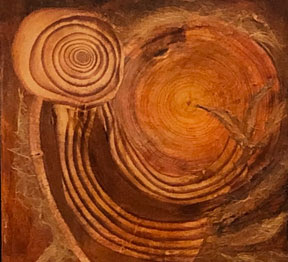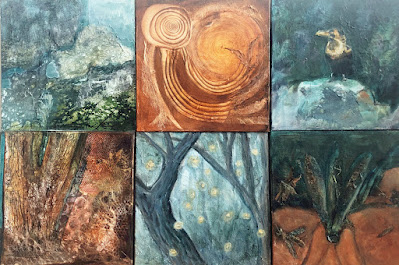
I’ve been thinking lately about what kind of artist I am. Every year we have a huge open studio event, Art a Whirl. This year of course it will be
virtual beginning May 15, so I need to succinctly present what I do in video. It is much easier to have hundreds of people traipse through my studio for three long days and chat with them.
I don’t think I am a typical artist, but of course there are many kinds of artists. By atypical I suppose I mean that I have many traits that are not associated with artists. I am analytical and “wordful.” Yes, I know that is not a word. Lest I be unaware, Word underlines it in squiggly red, but I am full of words and I use them to explain and make sense of the world. To paint and experiment, I have to shut that part of me down temporarily and play. I was never very good at playing even when I was a child so it is work for me to play. I need to trick myself into the zone of free association by painting and repainting, by not thinking of anything I do as too precious to paint over again. I have learned to view the seemingly false starts as part of the story of my evolving painting. It is through that process that I discover things I could not find through an analytical process. But then, ah, but then. . .I dust off my words and my analytic side and make sense of what just happened. I write about it. I follow the thread of my process. I use all of me to complete a painting fully, just not simultaneously.


I am an artist who is intrigued with story. Story is just a way to make sense of the world. To take the things that happen to us and around us and view them through a different frame. My artwork is about story and ideas. I love when there is a idea that a story illuminates. Even better when the story is housed in a painting. One of my favorite examples was when I painted about transformation, Stepping into the Chrysalis. I learned about nature’s story of transformation from caterpillar to butterfly, first consuming itself to turn into caterpillar soup, then drawing on its imaginal discs (stem cells with a very apt name) which contain the wings of the future butterfly. Not too unlike us consuming ourselves with worry as we face change and then finding our wings within. Then I had to find visual imagery to quite literally frame that amazing and metaphorical story.

When I think of the thread of my work, I realize I started with a puzzle. I began with a series on family history and the cornerstone was a self-portrait called Piercing the Veil. It was of me unveiling my family names with a paintbrush. Using art to tell the story of solving a puzzle. Of course, that’s what I do. It only took me twelve years from that painting to figure that out.
I followed that series with a body of work called the Silence Speaks Loudly as I tried to make sense of how Lithuania dealt with the Holocaust. I connected stories I gathered and observed while in Lithuania. Again, making sense of this often inexplainable world.
My interest in genealogy is a quest of sorts too, to understand the lives of my ancestors, of people who lived in a different time, but contained within a body, mind and emotions much like our own. What would it be like to live in a different environment? How would it change who we are? How would we experience the tides of history as they lapped up against our life? I have often wondered about the family members of mine who died in the Holocaust. Who were they as people? What was their day to day life like? What of them echoes in me? I began to explore that when I painted a Hole in Time, an exploration of the Jewish community in Radom, Poland.
Similarly, when I sought to make sense of my own Jewish identity, I interviewed Jewish elders. And after those interviews, I created artwork and then a book as I drilled down further into their stories to figure out how I fit within them.
When my mother lost memory and later when she died, I painted on memory, trying to find a way to make sense of first her loss of memory and then the loss of her. It was one long meditation on a wise woman who I carry within me. Absence and presence occupied me. Absence occupied me with her presence.
For the past eight years I have participated in a Jewish Artists Lab that takes a topic to explore and then creates artwork on that theme. That has proven to be a powerful engine, introducing me to ideas I might otherwise not have discovered. Through all of it I explored ideas that I translated into artwork. Memory palaces, transformation, imaginal discs, liminality, illuminating through parallel stories, identity as a river finding its banks, wisdom of the mothers.
I bring this lens to everything that I explore. Now I am working on the environment and I explore it through absence and presence, the idea of a 4700-year-old tree sounding the clarion call on global warming, arboreal ghost towns. It is a system where everything connects, a puzzle that we can solve if we can only focus on all of the pieces and each and every piece. And so, I wade into the immense puzzle of our world equipped with my paintbrush and my words.















